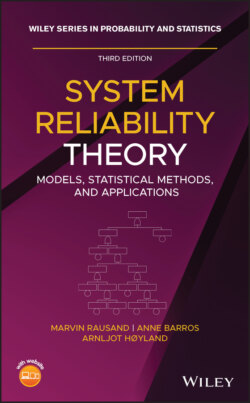Читать книгу System Reliability Theory - Marvin Rausand - Страница 55
1.7 Objectives, Scope, and Delimitations of the Book
ОглавлениеThe overall objective of this book is to give a thorough introduction to component and system reliability analysis by the system reliability approach. More detailed objectives are
1 To present and discuss the terminology and the main models used in system reliability studies.
2 To present the main analytical methods used in reliability engineering and management.
3 To present and discuss basic theory of maintenance and preventive maintenance modeling and illustrate how these can be applied.
4 To present the main theory and a selection of methods for reliability data analysis, which is also called survival analysis.
5 To give an introduction to Bayesian probability and Bayesian data analysis.
The book does not specifically deal with how to engineer and manage a reliable system. The main topics of the book are connected to how to define and quantify reliability metrics and to predict the reliability of a system. Our aim is that the book will be a valuable source as follows:
1 A textbook for system reliability courses at university level.
2 A handbook for reliability engineers in industry and consulting companies.
3 A reference book for scientists and engineers in related disciplines.
The following delimitations apply:
The study object is built of hardware parts based on mechanical, electrical, or electronic technology, and may or may not have embedded software and communication to/from the outside. In most cases, the study object has a human/operator interface. Operators and third‐party personnel are outside the scope of the book. This means that human reliability, as such, is not covered. The prime focus of the book is on hardware items.
The reliability of purely software items is outside the scope of this book.
Structural reliability issues are not covered in this book.
The focus of the book is on components and rather simple systems. The theory and methods presented may also be useful for analyzing complex systems, but we have to realize that they may not be sufficient.
Failures caused by deliberate hostile actions is covered rather rudimentarily.
In the main part of the book, we assume that each item can have only two states, functioning or failed. Multistate reliability is not covered properly.
A general introduction to maintenance is not provided. The presentation is delimited to aspects of maintenance that are directly relevant for system reliability.
The book provides a thorough introduction to system reliability analysis, but does not cover reliability engineering and reliability management in a sufficient way.
